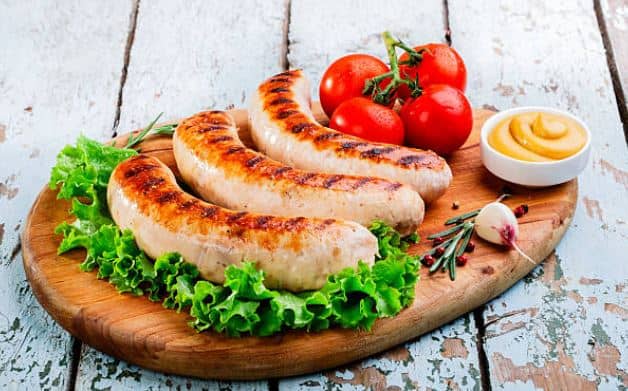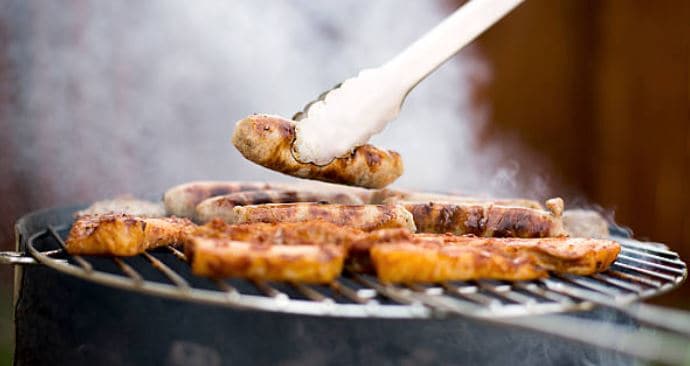If you’re in a hurry, you can tell if a chicken sausage is cooked by using the touch test. Raw sausage will be slightly slimy on the outside—especially if it has a thin, natural casing.
All sausages, including those with artificial casings, will be soft to the touch when uncooked. A fully cooked chicken sausage should have a uniform, firm texture and should be white or pale in color with no visible signs of pink.
You can also insert a meat thermometer into the thickest part of the sausage to make sure it’s the correct internal temperature (more on that below). This is especially helpful if you’re baking your chicken sausage in the oven.
Try doing a visual check on your sausage as well. Check for a change in color, or juices appearing on the surface after being cooked.
Finally, a fully cooked chicken sausage should make a sizzling sound when it hits a hot pan. If it doesn’t, it may not be fully cooked.
Table Of Contents:
Chicken Sausage Temperature (Guide)

165°F (74°C) is the recommended internal temperature for cooked chicken sausage. As I mentioned, chicken sausage has a lower fat content (and therefore a higher water content) than regular pork sausage. Therefore, it cooks much faster.
It’s important to cook chicken sausages thoroughly to ensure that they are safe to eat and free from harmful bacteria. Overcooking can result in dry and tough sausages, so it’s important to monitor the cooking process and remove them from heat as soon as they are fully cooked.
All food safety guidelines recommend cooking sausage to a temperature of 165°F, and this temperature will kill any and all harmful bacteria inside. Brown your chicken sausage over medium heat for the best flavor and texture.
Here’s how to tell if sausage is cooked, even if you don’t have a meat thermometer.
Check the color of the outside.
Fresh chicken sausages are light pink and may be translucent in appearance before you cook them. So if your chicken sausage is pink on the outside, it definitely needs more time to cook.
If you see that the sausage is white or translucent after cooking, that means it’s undercooked and should be cooked longer before serving.
If a chicken sausage is brown on the outside, it’s done and ready to eat! When it’s fully cooked, it’ll be dark in color with an opaque appearance on the surface.
Slice one open and look at the inside.
If you plan on eating the sausage immediately, test it to see if it’s cooked by slicing one open and look at the inside: if there are clear juices, your chicken sausage is cooked through. If the juices are pink, the sausage needs to cook for longer.
Tilt the sausage toward you — if juices run clear, it’s done.
When you’re cooking chicken sausages, the juices should run clear, not pink. If you tilt your sausage towards you and see pink liquid in the middle, then it’s not done cooking yet.
If there are no juices at all coming out of your sausage, then it hasn’t cooked long enough and needs to go back in the oven for another five minutes.
Thick-cut chicken sausage can be browned on both sides but still not fully cooked all the way through. This technique can also be used to check if there is any pink meat inside.
If there is any pink meat under that beautiful, crispy, golden-brown exterior, then something went wrong during your cooking process, and those sausages need more time in the oven before they’re ready to serve.
back to menu ↑
3 Best Ways To Cook Chicken Sausage (Guide)
1. Baking Chicken Sausage
Baking is a great method for cooking chicken sausage because it doesn’t require any oil or butter. If you’re hoping for a delicious sausage to enjoy with your breakfast or mix it into your favorite pasta dish, you’ll want to make sure it stays juicy throughout the cooking process.
A good way to do this is by baking your sausage in an oven that’s set at 400℉ (200°C). This will ensure that all of its juices stay inside where they belong!
Slice up some garlic and onions to toss onto your baking dish along with the chicken sausage! It’s a great way to add some extra flavor and variety to your meals. Salt and pepper can also be added for taste.
2. Cooking Chicken Sausage on the Stovetop
If you want to cook your chicken sausage quickly, then using a stovetop is an excellent option. You can add a little butter or oil to the pan if you like. But most sausage has enough on its own that you don’t need to add much.
You’ll want to heat up a skillet over medium-high heat while adding small amounts of water (or broth), oil, or butter as needed. Be careful not to add water to hot oil, or it may jump out and burn you!
Once this liquid begins bubbling lightly, place your sausage into the pan and cook for 7-10 minutes on each side. After removing your sausage from the stovetop, let it rest for a minute or two before slicing it.
3. Grilling Chicken Sausage

Cooking your sausage on a grill adds a nice charred flavor without sacrificing its juiciness. You can cook it with onions and bell peppers and throw it all together on a roll for a delicious sandwich.
Heat your grill to a medium-high temperature (about 400℉/200℃). Place your sausage on the grill so it comes in direct contact with the flame and cook it for about 20 minutes. Turn the sausage occasionally for a nice, even grill. Brown it for about 10 minutes on each side.
back to menu ↑
Conclusion:
When it comes to cooking sausage, it’s important to know what you’re doing. Otherwise, you could end up with a dry, overcooked piece of meat or even worse—a food poisoning diagnosis!
Keep these tips and tricks in mind when preparing your next meal with chicken sausage, and enjoy the deliciousness of this tasty treat without any worries about what might happen if you don’t cook it right.
back to menu ↑
Frequently Asked Questions
Can you eat slightly undercooked sausage?
If your chicken sausage is just slightly pink on the inside, you don’t have to panic. But it’s best to ensure it’s heated enough to kill harmful bacteria like salmonella. Symptoms of salmonella poisoning typically develop 12 to 72 hours after consuming contaminated food and can last for several days.
Symptoms can include nausea, vomiting, diarrhea, chills, fever, abdominal cramps, and fatigue. If you suspect you are suffering from salmonella, seek medical attention right away.
If the sausages look and smell good (no black spots, no foul odor), and you know how long they’ve been sitting out (hopefully not very long!), then you can safely chow down. However, if there are any signs of spoilage (see below), toss ’em!
In general, the USDA recommends cooking ground meats to an internal temperature of 160°F. That being said, salmonella is killed at 140°F, so if you want to err on the side of caution (even though it’s not necessary), go ahead and cook your patties all the way through. The same goes for poultry: 165°F will do it!
back to menu ↑
Is chicken sausage healthy for weight loss?
If you’re looking for a lower-fat and calorie alternative to pork sausage, consider chicken sausage. Chicken sausage is high in protein and iron. You can use it as an alternative to ground meat in many recipes or enjoy it as part of a healthy breakfast on its own or with egg whites and spinach. It’s higher in fat content than 3 oz of chicken breast, but it’s still a great source of protein.
Chicken sausage also contains zinc, which helps with wound healing, cell growth, gene regulation, and more. Zinc also benefits your immune system by keeping cold symptoms at bay while your body heals from the inside out.
back to menu ↑
How long does cooked sausage last in the fridge?
You should refrigerate cooked sausage within 2 hours of cooking. Cooked sausage will last in the fridge for about as long as banana pudding, up to 3-4 days.
If you want to store cooked sausage longer, freeze it. Frozen cooked sausage will keep for up to 3 months before it needs to be discarded.
back to menu ↑
How to tell if a chicken sausage is bad?
You can tell if a sausage is bad by checking its expiration date. If you see that it has gone bad, throw it away. However, some packaging contains a sell-by date instead. If this is the case, you don’t have to necessarily throw your food away by the listed best-by or sell-by date, but you will need to use your best judgment. Most foods are good for days or even weeks after this date.
Since this date is not regulated, it’s best to check for signs of your food going bad before throwing it away and wasting it. You should look at your package of sausages for signs of spoilage: mold, discoloration, and a bad smell can all indicate that food has gone bad.
If you still aren’t convinced about whether your chicken sausages are safe to eat, take a closer look at them (and smell them). If they seem okay but have been sitting out for too long, put them back in the fridge immediately!
As I’ve mentioned before in other articles on this blog – don’t let your food go bad.
Shanny
Shanny not only has an exceptional understanding of the foodie mindset and how nutrition works, she has also achieved her Master’s Degree in Education. Outside of her academic achievements, she loves writing food blogs. It's so much more than a list of meals though! Shanny creates helpful cookware guides and delicious recipes that are easy to follow. She does all of this as a food blog writer because she loves it. That's why she spends lots of time testing out different recipes in her own home. She truly is a one-of-a-kind foodie, from her home to yours - with a story to tell, new recipes to indulge in and new tips to tantalize those tastebuds.












